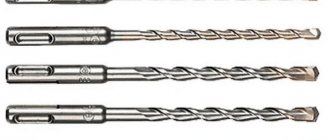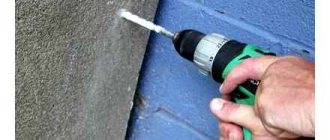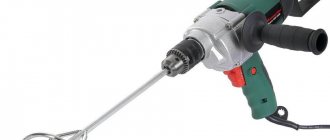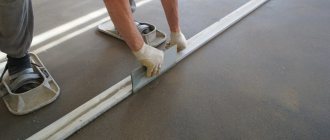A hammer drill is a special metal tool designed for punching holes of various sizes in hard materials such as concrete, brick or stone. The device is used when performing repair and construction work; it is an integral part of a hammer drill (impact machine). The drill is made from steel alloys, as a result of which it has the ability to pierce solid structures. When making the tip of the tool, an alloy of tungsten carbide and cobalt is used - it will win. Due to its robust design, the device has high performance and wear resistance.
What is a drill
A standard drill consists of several parts:
- shank - an element designed to attach a drill to a hammer drill chuck. It has several varieties and is located at the back of the device;
- spiral;
- core;
- cavity for dust removal - a special groove with the help of which the tool itself is cleaned of construction debris;
- carbide cutting plate - the tip of the device with which the work is carried out.
Hammer drill
What is a drill for a hammer drill, and what types are they?
The drill is the working part of the hammer drill. It is with its help that the tool makes holes in concrete, stone and brick.
The hammer drill differs from conventional drill bits in three main ways. Firstly, its job is not only to drill, but also to chisel, so the cutting head of the drill is usually rounded, and its design itself is designed to withstand greater impact loads than a drill. Secondly, the drill has a different shank design: while most drills today have a smooth cylindrical shank, the drill is attached to the chuck using grooves. They allow you to securely fix the equipment so that it does not rotate, and at the same time allow it to move along the longitudinal axis. Thirdly, the drill is installed in the chuck not anyhow, but with lubricant, which extends the life of both the equipment and the hammer drill.
Drill shanks can meet different standards. The most common today are various variations of the SDS standard developed by Bosch. The most popular: SDS+ (shank diameter 10 mm, 4 grooves) for compact models of hammer drills and SDS-Max (shank diameter 18 mm, 5 grooves) for more serious hammer drills.
The dimensions of the working part of drills can be very different, but the most common diameters in everyday life are 6, 8 and 10 mm. In addition to the diameter, the length of the working part of the drill is also important. Typically, in the marking of a drill, the first number indicates the diameter, and the second - the length. For example, a mark on the package “8x160” means a drill with a diameter of 8 mm and a working part length of 160 mm.
Most manufacturers of rotary hammers also produce drills for them. Among the highest quality ones we can name the already mentioned Bosch company, as well as DeWalt, matrix, domestic brands “Caliber” and “Granit”. The products of these companies are included in our independent Top 5 drills for rotary hammers.
Drill and drill, what's the difference?
A drill and a drill are completely different tools. The differences between the devices are presented in the table:
| Photo | Tool type | Application of the device | Installation for using the tool | Shank type | Grooves | Spiral shape |
| Boer | For punching impact-loaded openings | Hammer | Has an unusual appearance (SDS-Plus and SDS-Max). The element is equipped with grooves at the junction with the cartridge | Designed for removal of construction waste | The cutting edges can have different shapes (linear, wavy, etc.). The spiral has a special shape necessary for drilling hard material | |
| Drill | For drilling holes in rotary impact mode | Drill | Standard smooth shank | Used for cutting holes in material | Drills come in twisted and twisted single-spiral drills, suitable for processing soft materials, cast iron and steel |
It should be noted that the power of a hammer drill is several times higher than that of a drill, which is why the drill is strengthened more firmly than the drill. For the same reason, the wear resistance of the drilling rig is higher.
Drills for rotary hammers: what you need to know about their use
Despite manufacturers' claims about the durability of drills, they can fail. Most often, the period of use depends on the materials with which it comes into contact. The cause of a drill malfunction may also be considered to be improper use. Also, the owner of a hammer drill should not forget about the mandatory lubrication of tools.
The drill is practically not subject to restoration and repair. This is a consumable item, so it will be easier to buy a new drill. During the working process, the drill does not need to be removed from the hammer drill and cooled. There will be no overheating, and the drill itself heats up to a temperature that it can withstand.
Choose high-quality drills and use them for the specified purposes.
Types of drills
Tools are classified according to various parameters: design features, lengths and power, so there are a large number of their varieties.
Classification by shank type
The tail part of the drill may have the differences mentioned above:
- SDS - Plus - standard shank type. Its diameter varies from 10 to 40 mm. The fastening system consists of four grooves (two guides and two fixing ones). The length of products of this type is from 110 mm to 1 meter. Used in manual hammer drills;
- SDS - Max - has 18 mm in diameter. SDS-Max type devices are equipped with five slots (three open and two closed). Used when working with heavy hammer drills.
In addition, there are shank types SDS-top and SDS-quick, which are used much less frequently than the described installations.
Types of drills for rotary hammers
Shanks also differ in the number of edges:
- tetrahedral;
- hexagonal;
- cylindrical.
By diameter
When choosing a device, it is important to consider the required size of the future hole. This determines what diameter tool you need. The diameter of the drill varies from small (from 4 mm) to impressive (8 cm). Massive structures are used at construction sites and during road work. Large installations are used mainly by professional builders.
By lenght
The penetrating ability of the device depends on this parameter. A short, wide drill can make small holes in the material; on the contrary, a thin tool will punch deep holes and be a meter long.
Differences in drill shapes
Drill hole: features
Drills are used exclusively for working with a hammer drill. They are not used for drills. There are a number of different types of drill bits available, depending on the material you plan to work with. Metal, masonry and wood can be drilled using specially designed structures. They are adapted to the properties of a specific material and will help achieve the desired result with minimal effort and time. The range of drills also includes special products, for example for creating holes in glass surfaces or tiles. For these purposes, manufacturers produce drills with diamond tips made of tungsten carbide.
The quality of drills is determined by the material from which they are made. Accordingly, the type of material that they can drill is determined. Most often, drills are made from materials such as high-speed steel, with the addition of carbide, titanium, cobalt and other substances that improve the properties of the material.
Drills differ in the type of shank. Thus, straight shanks are used for chucks with and without a key for holes with a diameter of 10-13 mm. SDS shanks are used for corresponding rotary hammers. Hex shanks are used for screwdrivers.
Drills for stone and metal can be spiral-shaped, drills for wood can be twisted or flat. Drills come in different diameters and lengths. Extensions can be used if necessary.
Drill care
Any tool has an individual service life, which can be extended with proper care and use. Improper use may cause the device to fail prematurely.
Operating rules:
- It is not recommended to use your own weight on the hammer drill during operation.
- It is not allowed to operate the unit at idle speed (it may cause damage).
- When piercing hard surfaces, it is recommended to use a special lubricant and cool the drilling site with liquid.
- When drilling deep holes, you should use several tools, starting with a shorter drill bit, and changing it to a longer one as you work.
- When using the drill for a long time, it is necessary to pause and let it cool. To do this, the tool is placed in water/machine oil, and the hammer drill is disconnected from the network.
- The tool should be stored in a dry place, out of reach of children.
Care:
- Before use, as well as after use, the drill should be lubricated. This prevents dust from clogging the tool.
- Aerosols and oils that prevent the development of rust must be applied to the device according to the instructions that came with it upon purchase.
- Sharpening of the device can be carried out in cases where the drill manufacturer allows it.
Note! The device is sharpened using a diamond sharpening wheel. It is prohibited to use a grinder or a metal cutting disc to sharpen the drill. It may be dangerous!
When using the tool, you must follow safety precautions.
Video - Should I lubricate a hammer drill?
Working part of the drill
The working part of the drill that directly performs the drilling process is made of a metal alloy, and labor productivity and the safety of human use of the hammer depend on its condition. The working part can have different shapes and is classified according to purpose as follows:
- an auger drill is an excellent option for making deep holes of various diameters. Its spiral design and high torque allow it to effectively remove dust and sludge during operation, thereby reducing the load on the tool and reducing the time it takes to complete one hole.
- a drill with a small angle of inclination of the working grooves - for working with extremely little effort (for example, in Makita rotary hammers). Its purpose is the process of drilling a significant number of shallow holes.
- drill with a large angle of inclination of the working grooves , providing high drilling speed and productivity of the process itself. The load created on the hammer drill is higher than when using auger drills. Optimal for drilling single holes of great depth.
Drills with one or more spiral grooves, as well as grooves of specially designed shapes, ensure the stability of the drill, its balanced central placement during drilling, reducing vibration, and, consequently, the load on the hammer drill and the productivity of the work performed.
How to choose a drill for a hammer drill
When choosing a device, take into account the type and strength of the material you will be working with (concrete, stone, brick). There are also a number of factors that are recommended to be taken into account:
- manufacturer and price category. Devices vary in price. The market offers both expensive options for professional use and budget drills. When comparing quality and price, several manufacturers can be distinguished: Bosch, Makita, DeWalt.
- Hammer compatible. It is recommended to pay attention to the tool attachment. It can be designed for installation in a certain type of nest. When purchasing a device, beginners are advised to consult with the seller about the individual features of the rotary hammer.
- features of the spiral part. You should take a closer look at the steepness of the spiral part of the tool. The larger it is, the deeper the hole can be obtained by using the tool.
When choosing a device, you should take into account the strength of the material with which you will be working.
Pay attention to the advice of experts when choosing a drill for a hammer drill:
- choose devices with standard shanks. Many companies today focus on “original” elements, but it must be taken into account that not all products are suitable for working with a standard hammer drill;
- To punch shallow holes, use a drill with a flat spiral. It is worth noting that this design will last longer than its analogues;
- when purchasing a device, take into account the tasks and the power of the hammer drill;
- Be sure to check what material the tool is made of. For high-quality work, choose drills made of hard alloys;
- The number of cutting edges on a drill determines its speed and ability to process material of varying quality.
Video - Drill for drilling concrete
Categories of concrete drills
Categories of elements for providing holes in durable structures depend on the characteristics of the structure:
- Sharpened during the drilling process. Made for making recesses with a large diametrical cross-section. It is achieved due to the ability to spontaneously remove waste material, while the cutting part does not become dull, but rather is sharpened on the surface.
- Spiral. They cope with concrete surfaces with fairly high strength values.
- Flat arrangement of the spiral part. Their purpose is concrete structures with low strength. They require a lot of effort during the drilling process.
Diamond coated tools deserve special attention . With their help, concrete surfaces reinforced with reinforcement are processed. With their help, the work is done much faster and with better quality.
Varieties of products differ in their purpose. Their parameters are noted in regulatory documents. These include:
- crowns;
- impact-cutting;
- screw;
- flat.
There is an opinion that products are used only for working with concrete. But in some cases you have to work with wooden products. In such cases, wood drills are used. Its use brings a number of conveniences, the essence of which is as follows:
- unimpeded removal of chips;
- a minimum of effort is applied to achieve the goal;
- a special cutter eliminates the destruction of wood.
Voting for the best hammer drill
Which drill bit would you choose or recommend?
DeWalt EXTREME DT9571-QZ 14*600 mm
0.00 % ( 0 )
Granite 425100 25*1000 mm
11.11 % ( 1 )
DeWalt Extreme 2 DT7935B-QZ
22.22 % ( 2 )
Makita D-00050 6*100 mm
22.22 % ( 2 )
Granite Quadro-X 845570 45*570 mm
0.00 % ( 0 )
DS-MAX Bison 29350-340-12*340 mm
0.00 % ( 0 )
Bosch 2608833778 6*160 mm
22.22 % ( 2 )
Matrix 71098
0.00 % ( 0 )
CALIBER NB-13
11.11 % ( 1 )











